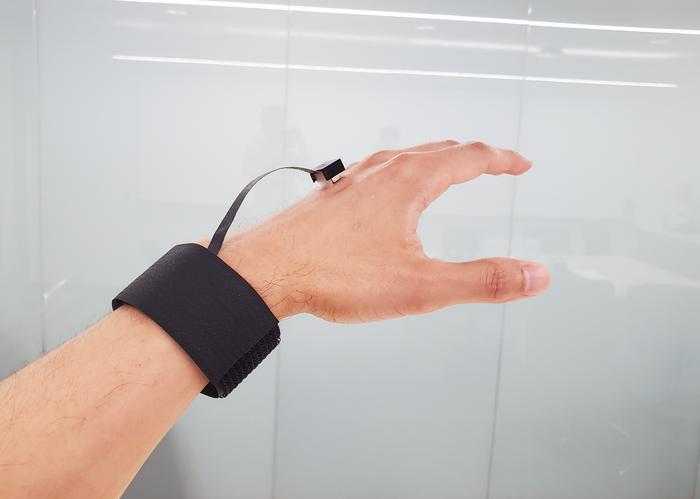In a groundbreaking advancement, researchers at Northwestern University have introduced a pioneering haptic feedback device that could redefine the way we experience touch in digital environments. This innovative technology transcends the limitations of conventional haptic systems that primarily rely on basic vibrations to convey sensations. With the capability to replicate complex tactile experiences, this new device promises to enhance interactions in virtual reality, assist individuals with sensory impairments, and revolutionize remote communications by providing a sense of touch that has long been missing in digital interfaces.
Located on the skin, the lightweight and compact device possesses an unparalleled ability to apply forces in multiple directions, mimicking intricate sensations such as pulling, twisting, stretching, and pressure. By precisely controlling these movements, the device can simulate various tactile experiences akin to those felt in real life. It integrates seamlessly with smartphones and virtual reality systems via Bluetooth connectivity, allowing for a wide-range application across different platforms. This feature alone presents exciting possibilities for entertainment and therapeutic domains.
One of the pivotal aspects of this device is its reliance on a rechargeable battery, signifying a move towards sustainability in technology. The device not only delivers tactile feedback but does so in a manner that is context-aware. Utilizing an embedded accelerometer, it detects its orientation and movement, ensuring that the feedback corresponds to the user’s actions. This intelligent response transforms simple interactions into immersive experiences, making activities such as online shopping or navigating virtual spaces feel tangibly authentic.
Leading the project, John A. Rogers articulated the need for a more sophisticated means of imparting touch, stating that traditional haptic devices often fall short, mostly limited to pushing against the skin. This innovation represents a paradigm shift in haptic design, aiming to engage with users in ways that mimic the natural complexity of human touch. By enabling multi-dimensional movement, the actuator can efficiently stimulate various skin mechanoreceptors, providing a more realistic perception of touch than ever before.
Moreover, this device introduces an unprecedented level of control over how sensations are experienced. Researchers have established that by combining multiple actuators into arrays, they can recreate nuanced feelings such as pinching or tapping, simulating what would traditionally be experienced through direct physical contact. As an example, when a user runs their finger across various textures on a touch screen, this technology can enrich the sensation, enabling them to perceive real-world tactile information digitally.
The implications of this technology extend far beyond entertainment. Aiming to assist individuals with visual impairments, the device could facilitate navigation through tactile feedback, helping users identify their surroundings and improve their spatial awareness. This accessibility feature reinforces the notion that technology can serve as a bridge, helping to diminish the gaps between various sensory perceptions, thus fostering a more inclusive digital experience.
Furthermore, as this device holds the potential to convey complex sound vibrations through the skin, it could unlock new realms for individuals with hearing impairments. By translating musical tones into tactile sensations, users may experience music in a wholly different manner, appreciating the richness of sound by feeling it resonate through their skin. This innovative interface broadens the understanding of how various senses can intertwine, presenting a more immersive auditory experience.
The team behind this research has established a multi-faceted approach to haptic feedback, focusing on more than just delivering vibrations. The device creates tactile responses that can change depending on the user’s interactions, making it adaptable to various activities—ranging from casual gaming to professional training simulations. The potential applications are extensive and could lead to collaborations across fields such as healthcare, entertainment, and education, where realistic haptic feedback can enhance learning and communication.
Interestingly, the device’s design was informed by previous research efforts that sought to create programmable arrays of vibrating actuators. By synthesizing knowledge from earlier studies with modern technological advancements, the Northwestern team has constructed an actuator capable of achieving full freedom of motion—a crucial feature that empowers it to provide varied and sophisticated tactile sensations. This newfound flexibility in movement positions the device as a formidable addition to the arsenal of haptic technologies available today.
In summary, the Northwestern University researchers are not merely introducing a new gadget; they are paving the way for future explorations of haptic feedback in ways that were previously unimaginable. As our digital experiences increasingly intertwine with our physical sensations, this device could serve as the key to unlocking richer and more immersive interactions. As the research community gears up for the formal publication of this study in the journal Science, the world watches with bated breath, eager to see how this technology will evolve and influence everyday life.
The continued intersection of technology and sensory perception not only holds promise for enhancing current digital experiences but also challenges our understanding of how we interact with the world around us. As these frontiers expand, the potential for modifying our perceptions through technology will offer profound implications. The era of tactile virtual interaction has dawned, ushering in a new chapter in the evolution of haptic technology.
Subject of Research: People
Article Title: Full freedom-of-motion actuators as advanced haptic interfaces
News Publication Date: 28-Mar-2025
Web References:
References:
Image Credits: Credit: John A. Rogers/Northwestern University
Keywords:
Tactile perception, Magnetic actuators, Mechanical systems, Wearable devices, Virtual reality




